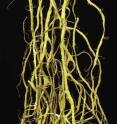University of Montana research unveils new player in lichen symbiosis
Related images
(click to enlarge)
Dating back nearly 150 years, a classic example of symbiosis has been the lichen: a mutually helpful relationship between an alga and a fungus. Now, that well-known dualistic relationship is being challenged. Researchers at the University of Montana, working together with colleagues from Austria, Sweden and Purdue University, have found that some of the world's most common lichen species actually are composed of three partners -- not the widely recognized two.
Their work, led by UM postdoctoral researcher Toby Spribille, will be published as the cover article in the July 29th issue of the journal Science. By using recent advances in genomic sequencing, the research team showed that many lichens contain not only the expected alga (the photosynthesizing partner) and fungus, but also a previously unknown second fungus that had never before been detected.
"This is a pretty fundamental shake-up of what we thought we knew about the lichen symbiosis," Spribille said. "It forces a reassessment of basic assumptions about how lichens are formed and who does what in the symbiosis."
This discovery came about when Spribille, working as part of UM microbiologist John McCutcheon's team, set out to answer why one of two closely related lichen species, common in western Montana, contains substances toxic to mammals while the other does not.
Previous DNA studies concluded that the toxic and nontoxic forms of the known fungal and algal partners of these lichens were identical, leaving unsolved the mystery of how one lichen acquires its toxic properties while the other does not. In fact, a longstanding riddle in lichen research has been that even in cases where the two known symbiotic partners are exactly the same, they sometimes combine to form lichens that differ wildly in appearance and in chemistry.
Spribille, who has studied the biology and taxonomy of lichens for 15 years, teamed up with McCutcheon, whose lab uses advanced genomic and microscopic tools to study insect symbioses, to see if they together could solve the mystery.
"When it comes to the study of lichens, he's one of the world's best -- a really high-class scientist," McCutcheon said. "What my lab could offer was experience with genomics on difficult samples, and -- because we traditionally work on insect systems -- a different perspective on symbiosis."
Spribille began by performing deep sequencing of ribonucleic acid, or RNA, from lichens. He ground up whole lichens - both the toxic and nontoxic samples -- and compared their RNA, whose job is to act as a messenger carrying instructions from DNA. To his surprise, he found that each lichen contained not one but two fungal species. What is more, he found that the toxic lichens contained far more of the extra fungus, which the team identified as a previously unknown form of yeast.
The researchers next began to suspect that this result was not an isolated phenomenon.
They began to check other lichens and eventually sampled material from all over the world. It turns out, the second fungus was found in common lichens worldwide -- from Antarctica and Japan to South America and the highlands of Ethiopia.
"It's everywhere," McCutcheon said. "This thing has basically been hidden in plain sight for more than 100 years. People were probably looking right at it, and they thought they knew what they were seeing, but they were actually seeing something else."
Now that the research team understands that the new fungus is globally distributed and seems to be an integral part of the symbiosis, they will set out to understand what it really does.
"The word symbiosis in part comes from the study of lichens," McCutcheon said. "The textbook definition of lichen has always been restricted to one fungus and one fungus only. Our work shows that this definition doesn't seem to be correct."
The paper is available online at http://science.sciencemag.org/lookup/doi/10.1126/science.aaf8287.
Source: The University of Montana
Articles on the same topic
- Lichen: Apparently happy couple really a threesomeFri, 22 Jul 2016, 17:27:22 UTC
- Yeast emerges as hidden third partner in lichen symbiosisThu, 21 Jul 2016, 20:38:48 UTC
Other sources
- Lichen: Apparently Happy Couple Really a Threesomefrom Newswise - ScinewsSat, 23 Jul 2016, 3:21:14 UTC
- University of Montana Research Unveils New Player in Lichen Symbiosisfrom Newswise - ScinewsSat, 23 Jul 2016, 3:21:13 UTC
- Yeast emerges as hidden third partner in lichen symbiosisfrom Science DailyThu, 21 Jul 2016, 20:31:09 UTC
- Lichens aren't quite what we thought, shocked scientists discoverfrom CBC: Technology & ScienceThu, 21 Jul 2016, 19:01:10 UTC
- Yeast emerges as hidden third partner in lichen symbiosisfrom PhysorgThu, 21 Jul 2016, 18:12:30 UTC
- [In Depth] A lichen ménage à troisfrom Science NOWThu, 21 Jul 2016, 18:11:16 UTC

